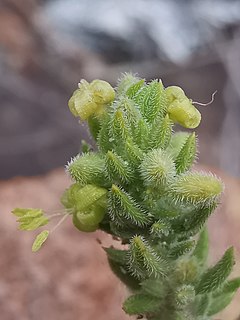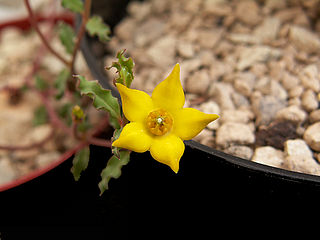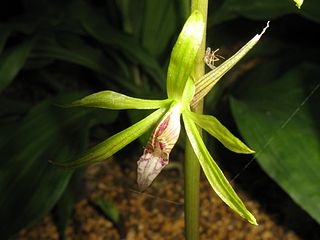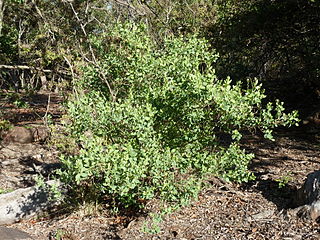
Tulbaghia is a genus of monocotyledonous herbaceous perennial bulbs native to Africa, belonging to the Amaryllis family. It is one of only two known genera in the society garlic tribe within the onion subfamily. The genus was named for Ryk Tulbagh (1699–1771), one time governor of The Cape of Good Hope.

Crinum is a genus of about 180 species of perennial plants that have large showy flowers on leafless stems, and develop from bulbs. They are found in seasonally moist areas, including marshes, swamps, depressions and along the sides of streams and lakes in tropical and subtropical areas worldwide.

Phaius, commonly known as swamp orchids or 鶴頂蘭屬/鹤顶兰属 , is a genus of forty five species of flowering plants in the orchid family, Orchidaceae. They are evergreen, terrestrial herbs which form clumps with crowded, sometimes stem-like pseudobulbs, large, pleated leaves and relatively large, often colourful flowers. Species in this genus are found in the tropical parts of Africa, Asia, Southeast Asia, New Guinea, Australia, and various islands of the Pacific and Indian Oceans. One species is also naturalized in Hawaii, Florida, and the Caribbean.

Anthospermum is a genus of flowering plants in the family Rubiaceae. It is found in Tropical and Southern Africa, Madagascar and in southwestern Arabian Peninsula.

The genus Brachystelma is represented by over a hundred species in the world, chiefly distributed in South Africa, South-East Asia and Australasia. In India, 17 species are known to occur, of which nine are endemic.

Nervilia, commonly known as shield orchids, is a genus of orchids with about 80 species widely distributed across most of sub-Saharan Africa, southern Asia, Australia, and various islands of the Pacific and Indian Oceans. Six species occur in Australia, with 16 in India, 10 in China and 5 in South Africa.

Cryptolepis is a plant genus in the family Apocynaceae. It includes some 42 species.

Clutia pulchella, the lightning bush, is a southern African dioecious shrub of the family Peraceae. It occurs at middle altitudes in Namibia, Mozambique, Zimbabwe, Swaziland, Botswana, Lesotho and South Africa.

Aceratium is a genus of about 20 species of trees and shrubs of eastern Malesia and Australasia from the family Elaeocarpaceae. In Australia they are commonly known as carabeens. They grow naturally in rainforests, as large shrubs to understorey trees and large trees.

Englerophytum natalense, the silver-leaf milkplum, is a medium-sized, evergreen tree that occurs along forested escarpments from East Africa to South Africa. The leaves are alternately arranged or spiralled, and to some extent crowded near the ends of branches. They are glossy green to greyish green above and covered in silvery hairs below. The stem is straight and the bark smooth. Young branches are covered with dense brownish hairs. The plant contains a milky latex.

Cryptolepis oblongifolia, the red-stemmed milk rope, is a multi-stemmed shrub in the family Apocynaceae. It is native to moist and mesic regions of southern Africa, where it occurs in rocky grassland, grassy woodland or riverine vegetation. It is found from South Africa to Zambia. It grows about 1m tall, and carries widely spaced, opposite leaves on the reddish-brown stems. The yellow to reddish-yellow flowers appear in axillary clusters.
Aspidoglossum is a genus of plants in the family Apocynaceae, first described as a genus in 1838. It is native to Africa.

Raphionacme is a plant genus in the family Apocynaceae, first described as a genus in 1842. The genus is found primarily in Africa, with one species on the Arabian Peninsula.

Carex cryptolepis, known as northeastern sedge, is a North American species of sedge first described by Kenneth Mackenzie in 1914.

Nuxia congesta, commonly known as brittle-wood, is a species of tree in the Stilbaceae family, with an extensive range in the Afrotropics. The species is named congesta for its dense inflorescences.
Balanites glabra is a species of tree or shrub, classified either as a member of the Zygophyllaceae or the Balanitaceae. This tree is native to East Africa.
Balanites pedicellaris, the small green-thorn or small torchwood is a small tree or shrub from Sub-Saharan Africa. It is a member of the caltrop family Zygophyllaceae.














